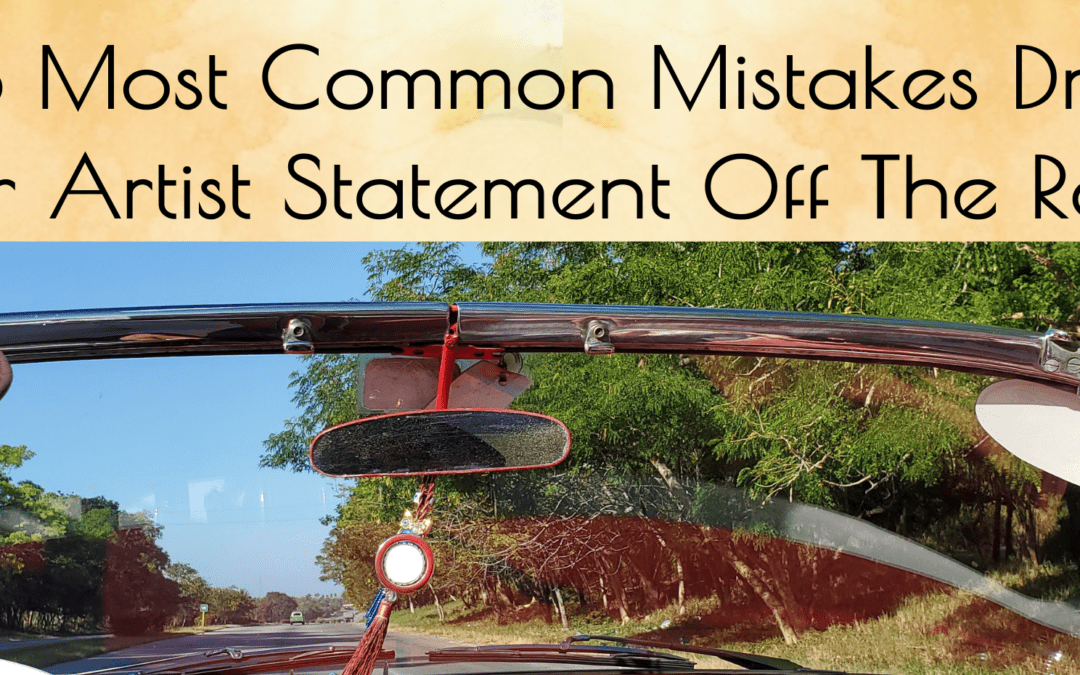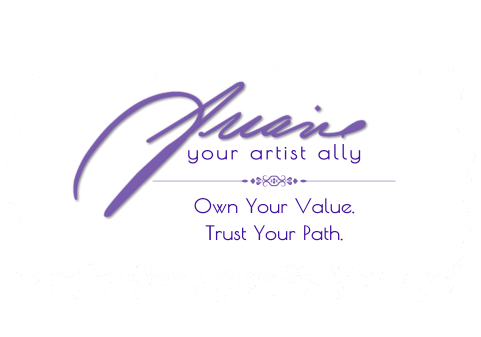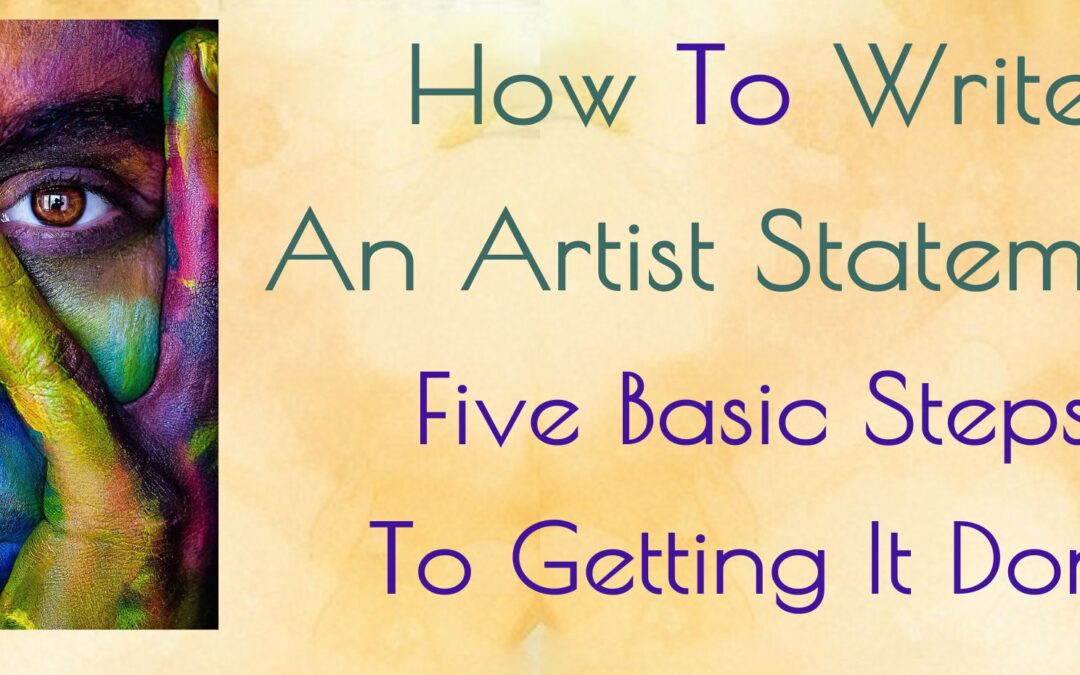
The 3 Most Common Mistakes Driving Your Artist Statement Off The Road
When you have your professional act together, and you are producing your best artwork, you stand out from the fast lane of competition.
A sophisticated, compelling artist statement gives you an edge that marks you as more professional than an artist who ignores this critical element in their portfolio.
Here are three, curable mistakes, which artists repeat so often that it plays a major role in tainting the credibility of even a viable, exciting artist statement.
Read and heed…

Most Common Artist Statement Mistake #1: Confusing an artist statement with a critique, a resume, or a bio.
A resume is not an artist statement because a resume is a list, by date, of all the pertinent, professional events in your art life. These events help convince people that you are an artist worth collecting.
The list, with items that directly relate to your art, includes: education, awards, exhibits, publications, collectors, grants, gallery representation, etc.
Never confuse a resume with an artist statement. A resume is informative, an artist statement inventive. A resume is dry; an artist statement is juicy.
Unlike the artist statement, a resume will not illuminate your work. It will not get into your viewer’s head and stay there. It will not add anything of experience to the viewer looking at a piece of your work.
A resume allows your work to be properly filed. An artist statement allows your work to be extra-remembered because now you’ve tapped into two major area of your viewer’s brain: visual language and word language. Together, these two languages create a sticky factor that’s hard to unstick.
When done well, your artist statement excites our human thirst for story in a few short paragraphs.
A critique is not an artist statement because a critique evaluates your artwork. An artist statement illuminates your artwork, expands the experience of your artwork.
A critique is about likes and dislikes, comparisons and labels, how your work does, or does not, fit into a particular art scene/theory. A critique distinctly reflects the “opinions” of others as opposed to the “personal reflections” of you, the artist.
A critique often tries to speak for the artist, and this industry standard is one of the reasons I strongly believe you must write your own artist statement.
Only you can speak to your experience of a piece, of a series, of the art-making itself. Only you, the artist, has the inside scoop.
When you willingly give this critical piece of your creative work away to critics, you not only cheat yourself of the opportunity to weigh in on your work, you cheat your viewers of your unique perspective.
A bio is also not an artist statement because a bio summarizes the areas of your personal history that have impacted your art.
What are the major “moments” in your artistic journey? How has your artwork influenced your life, and vice versa? What, and who, orbits around your art world?
A bio is not a list like a resume. It is more akin to the three paragraphs of prose you find in an artist statement.
The tricky part is that your artist statement may include relevant biographical tidbits, but it is not, in its entirety, a bio.
I recommend you write your artist statement before you write your bio. That way, when you write your bio, you can use different bits of your ArtLife history so these two portfolio elements remain distinct from each other.
An artist statement is not a resume, critique or bio because it alone reveals the true spirit of your relationship to your artwork. This is its powerful secret. It creates an emotional bridge between the person who views a work of art and the artist who did the work. At its best, an artist statement celebrates your work by creating a deeper connection between art, artist, and audience. It holds the potential to intensify the emotional and intellectual ties already established by the power or beauty or surprise of the artwork itself.

Most Common Artist Statement Mistake #2:
Using the third person (Jane Doe/John Smith/Your Name)
- This happens most often when artists make these three mistaken assumptions: Thinking that their statements need evaluative comments (Mary /Jack Ripple’s sculpture excels in the lost wax technique…)
- Thinking that their work needs authoritative commentary (Ryan Caplan’s watercolors open up a whole new direction for…)
- Thinking that no one will take them seriously if they write about their own work. (Stashing away a little “i,” so it can be ready to pull down the more powerful and assertive big “I,” sends the wrong message: that this artist lacks confidence in the authentic power of personal truth.)
Artists, who use third person, simply don’t understand how much the viewer craves a peek behind their canvasses.
When you write about the artist’s process — your relationship to your work — first person is the most direct, honest way to do it.
First person (I) gives an artist statement the authenticity and sincerity it deserves.
Authenticity, or the ability to speak to the true essence of a thing, actually creates a more powerful aura of authority than using the third person. For, after all, who better to speak about an artist’s work than the artist herself?

Most Common Artist Statement Mistake #3:
Using negative or put-down statements about artist statements, yourself or your art
If there is one mistake that hoists up a “RunForYourLive,” red flag for collectors and art viewers, this is it.
Can I tell you how many times I have seen a variety of:
“Now, I don’t even like artist statements, but…” or…
“I think writing an artist statement is useless, but here goes…” or …
“My work speaks for itself, but since I have to write this…”
And…
“I hope my work xxxx”
“I’m trying to xxxx”
“Eventually, I’ll get there…”
These negative or subtly dismissive messages create an instant, knee-jerk response in a reader, who instinctively pulls away. It’s like a super charged, anti-magnet.
The negative and dismissive messages create a force field of heavy energy for readers, who feel as if they’ll get sucked in if they get too close.
Negative commentary also spills onto the artwork itself. It sends a strong, subliminal message that, since a statement is about the relationship between artist and artwork, the artist might not like their work any better.
Worse, it sounds immature; not intellectually casual, wryly sophisticated, or thought provoking – which, I suspect, is what the artist who writes this way imagines.
The contempt and ambivalence in put-down statements overshadows anything else an artist wants to get across. “Why then,” we wonder, “are you bothering?”
In spite of misgivings, you bother because there is a nagging feeling that an artist statement is important. The problem is not the artist statement itself, but a confusion over what an artist statement is and what it accomplishes.
TIP: Every time you are tempted to use these three letters in your artist statement — b u t – you have just entered the red flag zone. Time to find out if one of your artist *fears is curled up behind your “I’m-a-cool- artist” door, doing what fears do best: leading you down the wrong path with great confidence.
When you use an artist statement to speak to the deepest truth about your art, even if that truth is sparse and obvious to you, its very authenticity resonates and pulls the reader closer to your work, closer to the heart of the art experience you are creating.
![]() *fear
*fear
I’ve outlined the 7 Dragons of Fear in the third edition of the original book on artist statements: Writing The Artist Statement: Revealing the True Spirit of Your Work.
A fear only works when it isn’t named. Once you understand the false premise behind any fear, it’s fearsomeness shrinks to a grain of sand. And yes, these 7 fears affect how (or whether you will or will not write) an artist statement. They also show up in other areas of our life.
![]() This book will push start the process of writing an earnest and meaningful artist statement.
This book will push start the process of writing an earnest and meaningful artist statement.
It is motivating, reassuring and provides an easy workable approach that removes the barriers to writing your statement.
Complete the exercises and your finished statement will connect the artist to the artwork in a way that others will enjoy and understand.
This book is a great addition to any artist’s reference library.
~ R. H. McMurray, ex-president of the Federation Of Canadian Artists
![]()
There are even more critical mistakes that you can make on your artist statement. Each one spells “Amateur!” to potential galleries and exhibition spaces.
Why take the chance?
Your work deserves an artist statement that gives you the professional edge you need…read more.

P.S. Before presenting your artist statement, you have to write it.
No worries, I developed an easy process streamlined for artists.
Follow the guidelines in my definitive book on artist statements: Writing The Artist Statement: Revealing The True Spirit of Your Work — one easy chapter at a time.
Write it once, and you’ll have a system in place as your artwork evolves.






